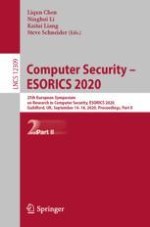2020 | OriginalPaper | Chapter
Updatable Blockchains
Authors : Michele Ciampi, Nikos Karayannidis, Aggelos Kiayias, Dionysis Zindros
Published in: Computer Security – ESORICS 2020
Publisher: Springer International Publishing
Activate our intelligent search to find suitable subject content or patents.
Select sections of text to find matching patents with Artificial Intelligence. powered by
Select sections of text to find additional relevant content using AI-assisted search. powered by
